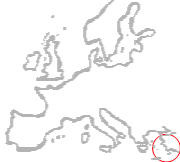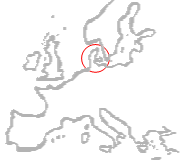



Paphos in the southwest of Cyprus has been selected as a European Capital of Culture for 2017, along with Aarhus on the east coast of Denmark's Jutland peninsula.
The music of Cyprus includes a variety of traditional, Western classical and Western popular genres. Cypriot traditional music is similar to the traditional music of Greece and includes dances like sousta, syrtos, tatsia, antikristos and zeimbekiko.


Cyprus changed hands numerous times prior to the medieval era, and was an important outpost of Christianity and Western European civilization during the Crusades. The island's peak as a cultural capital of Europe occurred from 1359 to 1432. During that peak, Pierre I de Lusignan made a three-year tour on Europe, bringing with him an entourage of musicians that impressed Charles V in Rheims so much that he donated 80 francs in gold to them. On his return to Cyprus, Pierre I brought with him the French Ars Nova and, later, the Ars Subtilior. French musicians became well established in Cyprus, and the city of Nicosia became a capital of the Ars Subtilior style. Janus I de Lusignan saw Cypriot music evolve into its own variety of music. His daughter, Anne de Lusignan, brought a manuscript after her marriage to Louis, Count of Geneva, which contained 159 folios with over two hundred polyphonic compositions, both sacred and secular. The manuscript is now a part of the collection of the National Library of Turin.
A key-figure of that era was Ieronimos o Tragodistis (Hieronymus the Cantor), a Cypriot student of Gioseffo Zarlino, who flourished around 1550-1560 and, among others, proposed a system that enabled medieval Byzantine chant to correspond to the current contrapuntal practices via the cantus
The music of the island is influenced also by the Byzantine music. Athanasios Demetriadis, also known as Kasavetis, was a Cypriot deacon in Constantinople when Ecumenical Patriarch of Constantinople was his uncle Yerasimos (1794–1797). A secular song lamenting Death's preference for the young, written and set to music by him survives in a collection by Nikiforos Naftouniaris. Chrysanthos of Madytos, Gregory the Protopsaltes, and Chourmouzios the Archivist were responsible for a reform of the notation of Greek ecclesiastical music. Essentially, this work consisted of a simplification of the Byzantine musical symbols which, by the early 19th century, had become so complex and technical that only highly skilled chanters were able to interpret them correctly.
Traditional music on Cyprus is similar to the traditional music of Greece and includes dances like the tatsia, sousta, syrtos, zeibekiko and the karsilama suites. Note that unlike Greece and Turkey, there are suites of four karsilama dances, different for men and women, some of them other than the standard 9/8 rhythm. Traditional Cypriot music – similar to Greek and Turkish traditional music – is modal, based on the musical systems of the Byzantine echos and the Turkish makam. Both Greek and Turkish Cypriots use the violin as the main solo instrument, accompanied by the lute for Greek Cypriots and the ud for Turkish Cypriots. The tamboutsia and the pithiavli are also used. Notable performers of Greek Cypriot folk music include singers Michael Tterlikkas, Christos Sikkis, Michalis Hatzimichail, Kyriakou Pelagia and Ilias Kouloumis. A niche artist of traditional music is Gianni Delfinogamis, a champion of many tshiatísta (Cypriot Greek: τσιατίστα, "spite [song]") competitions. The tsiatísta is improvised antiphonal singing akin to the Cretan mantinada, with satirical and comedic intent, usually performed between friends or relatives poking fun at each other. Greek-Cypriot folk music is most closely related to the Nisiotika (the folk music of the Aegean Islands) and especially so to the music of the Dodecanese.
Attempts to either popularize or fuse traditional music with other genres have taken place since the 1970s. For example, the famous singer and composer, in Cyprus and Greece, of traditional Cypriot and popular music is Mihalis Violaris. Another example includes Monsieur Doumani, a Cypriot band from Nicosia which focuses on developing Cypriot traditional music and reworking traditional Cypriot folk songs.
One of the most successful and recognised world music groups in Cyprus is Monsieur Doumani. The group was formed in Nicosia in 2012 and has released two albums, Grippy Grappa (2013) and Sikoses (2015). The band focuses upon the unique character of Cypriot folkloric music, enriching traditional songs with new arrangements, melodies, rhythms and sounds and crafting a style distinctively their own. The band’s music is a blend of the traditional element with modern genres.Their repertoire also includes their own compositions in the Cypriot Greek dialect, which are inspired by contemporary Cypriot society, as for example the recent financial crisis that hit the island and the corrupted political system. Monsieur Doumani was nominated for "Best Newcomer" in Songlines Music Awards 2014 and participated in acclaimed festivals around the globe such as WOMAD Charlton Park 2014, Sommarscen Malmö, Songlines Encounters Festival etc.
In 2008 the electronic/world music group Mikros Kosmos ("small world") arrived in Cyprus and recorded their first album in Nicosia. Their first performances presented live remixes for laptop and voice of classic Greek rebetika, with performances at New York City's Golden Festival and elsewhere in the United States. Mikros Kosmos's full-length original album moves away from the classic rebetika with an affection for minimal arrangements and a lyrical abstraction which is uncommon in the history of Greek music.

Text is available under the Creative Commons Attribution-ShareAlike License.
Date: February 2017.
Photo Credits:
(1ff) Logos,
(7) Monsieur Doumani
(unknown/website).